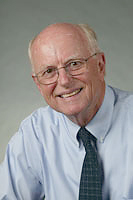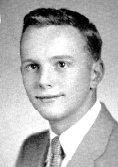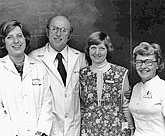
Class of 1956
Honoring Dr. John Kersey
|
Cancer Center head honored for lifetime achievement Dr. John Kersey, director, University of Minnesota Cancer Center, received the 2003 Lifetime Achievement Award from the American Society of Blood and Marrow Transplantation (ASBMT). The award cites his pioneering work in blood and marrow transplantation and his major contributions to the current understanding of childhood leukemia. "Dr. Kersey has been one of the leaders in our field, especially in the translational science of human acute leukemia," said John Wingard, ASBMT president. |
 |
|
In 1975, Kersey and colleagues performed the world's first successful bone marrow transplant for lymphoma. The patient was a 16-year-old boy with a rare form of cancer called Burkitt's lymphoma, which at the time was a fatal disease. That patient is now a husband and father in his 40s and doing well. At the forefront of understanding the role of stem cell transplants for leukemia, Kersey was among the first to recognize that leukemia represents distinct stages of normal lymphocytes, including T-cells. Kersey was a force behind the creation of the University of the Minnesota Cancer Center, which was established in 1991 and designated a Comprehensive Cancer Center by the National Cancer Institute in 1998. Kersey earned his medical degree in 1964 at the University of Minnesota Medical School. He completed residencies in pathology, immunology, oncology, and pediatrics at the University of Minnesota and then joined the faculty. From 1974 to 1995, he was director of the University's Bone Marrow Transplant Program, which trains scientists from around the world. He is the author of nearly 500 medical journal articles. |
|
John Kersey, M.D., is the founding director of the University of Minnesota Cancer Center which became a National Cancer Institute-designated comprehensive cancer center in 1998. He currently holds the Children's Cancer Research Fund Endowed Chair in Pediatric Oncology and is a Professor in the University of Minnesota Departments of Laboratory Medicine/Pathology and Pediatrics. Dr. Kersey attended Dartmouth College (B.A.), Dartmouth Medical School (B.M.S.) and Medical School at the University of Minnesota (M.D. 1964). His research interests began in medical school where in 1960-61 he completed early studies of the role of the thymus in immune system development under Drs. Carlos Martinez and Robert Good. |
 John Kersey in 1956 |
|
He completed residencies in pathology and pediatrics at the University of Minnesota and has been a faculty member since 1973. Prior to founding the University of Minnesota Cancer Center, Dr. Kersey directed the university's Blood and Marrow Transplant Program from 1974-1995. The program now trains scientists from around the world and annually receives several million dollars in National Institute of Health research grants. As Blood and Marrow Transplant Program director, Dr. Kersey led the team that completed the world's first successful bone marrow transplant for lymphoma in 1975. Dr. Kersey's research accomplishments include pioneering work in the development of some of the earliest monoclonal antibodies for leukemia study in the early 1980s, and the subsequent use of these antibodies for cleansing the bone marrow of leukemia cells prior to reinfusion of a patient's own bone marrow. Honors and Awards
|
|
| The world's first bone marrow transplant Thirty years ago, doctors at the University of Minnesota inserted
a syringe into David Stahl, a 16-year-old suffering from advanced
lymphoma, and injected him with disease-fighting bone marrow donated
by his little brother. |
 Dr. John Kersey in 1978 with three members of his bone marrow transplant team. |
|
Stahl is one of many who have received a new lease on life at the University, where transplant pioneers have performed the world's first pancreas transplant, the first intestinal transplant and more than 7,000 kidney transplants, among many other medical milestones. Stahl's family was willing to try the experimental procedure because
his prognosis was so grim. Doctors who discovered the grapefruit-sized
tumor in his stomach said he had just a 5 percent chance of survival
using the standard treatments available in 1975 for lymphoma, which
attacks the body's immune system. Dr. John Kersey, director of the University's Cancer Center, decided that a transplant was Stahl's best chance. Dr. Kersey believed that clean marrow would give his patient a new, rejuvenated immune system capable of fighting the tumor. First, Stahl's own diseased marrow was effectively killed off through a course of radiation. Then the transplant from his brother, a perfect match, was carried out. Today, bone marrow transplants like the one performed on Stahl are a standard treatment for people with lymphoma and many other forms of cancer, and have saved thousands of lives. Another lasting impact of Kersey's innovative procedure was that it spurred research into stem cells, the building blocks of the human body. While it wasn't clearly understood at the time, stem cells enable transplant patients to regenerate healthy tissue -- and they may hold the key for treating terminal illnesses like Parkinson's and Alzheimer's. David Stahl recovered from his own "incurable" disease and today is a 46-year-old golfer, fisherman and father living in Golden Valley, Minn. |
Information and photos compiled from various University of Minnesota Websites.